Clash of Titans
Games featuring a future Hall of Fame coach on each sideline.
November 2, 1907: Michigan @ Vanderbilt
Fielding Yost vs Dan McGugin
Dan McGugin was Fielding Yost's third key recruit at Michigan in 1901 after HB Willie Heston and lineman George Gregory. Like Heston, McGugin had already graduated from college, in his case Drake University in Des Moines IA. He was described as "a first-rate blocking guard with uncommon speed, even if at 180 pounds he was undersized." A Yost teammate from the 1896 Lafayette team was Drake's coach, and he tipped Yost about McGugin's talents.
Michigan athletic director Charles Baird arranged for McGugin to enroll in the Michigan law school. That made McGugin eligible to play for the Wolverines. The problem was that Dan had already played four years at Drake. But he persuaded the Michigan Board of Admissions that he was a preparatory student in the first two of those years. So he still had two years of eligibility.
McGugin started at guard for Michigan's "Point-a-Minute" teams in 1903 and 1904 that outscored their opponents an astounding 1,211 to 12. He then served as Yost's assistant coach in 1903.
After the 1903 season, Vanderbilt was looking for a head coach. So a letter was sent to the most famous coach in the land asking for a recommendation. Yost sugigested McGugin. Let Dan tell the story from here.
I wrote Vanderbilt, cautiously offering my services but received no response. One day ... I had a telegram from Western Reserve at Cleveland offering me the job there and asking for an immediate reply. I went to telegram office and wired acceptance, and when I walked back to the Delta Upsilon house, I found a telegram from Vanderbilt definitely offering me that place.
Vanderbilt offered $850 and Western Reserve $1,000, but I wanted to come South and see and know the people. I decided that if I could recall the telegram to Cleveland before its delivery, I would go to Vanderbilt. Otherwise I would go to Western Reserve. The telegram was recalled before delivery by three minutes.
Vanderbilt offered $850 and Western Reserve $1,000, but I wanted to come South and see and know the people. I decided that if I could recall the telegram to Cleveland before its delivery, I would go to Vanderbilt. Otherwise I would go to Western Reserve. The telegram was recalled before delivery by three minutes.
McGugin wasted no time elevating Vanderbilt football to new heights. He installed the Michigan "hurry up" offense. His 1904 squad went 9-0-0 and remains the only undefeated, untied team in school history. Eight of the games were shutouts with Missouri Mines scoring a four-point field goal. The Commodores led the nation with 452 points.
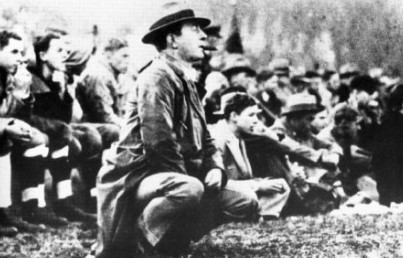
Dan McGugin watching from the sidelines at Vanderbilt.
Vanderbilt Athletic Communications
Fred Russell, longtime sports editor for the Nashville Banner, wrote a memoir of his career entitled Bury Me in an Old Press Box. He wrote this about McGugin.
A man didn’t have to play football under McGugin to get to know him well, or to comprehend—and admire—his coaching philosophy. To him, teams were men, not machines. He was hearty, convivial, with big, kindly Irish eyes of blue, and an infinite deal of wit. ...
While McGugin had brought new techniques to Southern football, and was a clever strategist, his foremost quality was the ability to inspire men. Not as a staccato fire-eater, like Knute Rockne; Dan spoke softly and slowly. He was a master of psychology, keying a team with an almost-sacred approach, or breaking tension with some hilarious prank or remark.
While McGugin had brought new techniques to Southern football, and was a clever strategist, his foremost quality was the ability to inspire men. Not as a staccato fire-eater, like Knute Rockne; Dan spoke softly and slowly. He was a master of psychology, keying a team with an almost-sacred approach, or breaking tension with some hilarious prank or remark.
The brothers-in-law agreed to a 1905 game between their two squads in Ann Arbor. Vanderbilt didn't score a point but managed to hold Michigan to 18, the Wolverines' lowest total in their first five games to that point in the season.
That was the lone defeat in the Commodores' 1905 season. Six of their seven victories were shutouts. They finished atop the loosely organized 14-team Southern Intercollegiate Athletic Association football standings.
In 1906, McGugin married Virginia Fite of Nashville with Yost serving as best man. Yost met Virginia's twin sister Eunice and later married her, making the two coaches brothers-in-law. Yost began spending his off-seasons in Nashville, where he was available to help McGugin develop the Vanderbilt program.
The '06 Commodores returned to Ann Arbor and gave the Wolverines a tougher game. The 10-4 defeat before 10,000 fans was the only blemish on Vanderibilt's slate for the second year in a row. The 10 points they gave up, together with Georgia Tech's six points two weeks later, were the only blemishes on the defense's record that season.

1907 Vanderbilt football team (Vanderbilt University Commodore Yearbook Class of 1908)
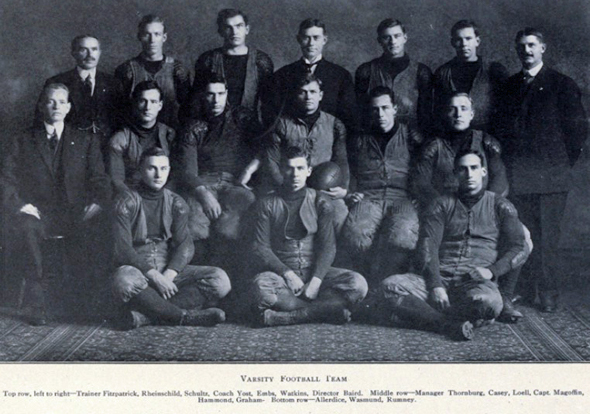
1907 Michigan football team (University of Michigan Michiganensian Yearbook Class of 1908)
Coach Fielding Yost is the middle of the last row.
Featured Player
Adolph "Germany" Schulz, Michigan's center, was a 6'4" 220lb behemoth (who would grow to 245lb) from Fort Wayne IN who had the grace and quickness of a cat. He could play all 70 minutes of each game at top speed without tiring.
He was the first "roving center" to drop back from the line a foot or two on defense, becoming what today is known as a "linebacker." He was also one of the first centers to use a spiral pass to the backfield to start an offensive play instead of the end-over-end snap.
He was involved in one of college football's earliest recruiting controversies. He was 21 when Coach Yost invited him to attend Michigan and play football. He had worked in an Indiana steel mill and played for amateur and – possibly – professional football teams.
Schulz bristled when accused of being a "ringer" whom Yost recruited just to play football. He insisted that he did not "come out" of the steel mill to play. Instead, he "went into" the mill to harden himself for football.
One day while working in the steel mill, he was summoned to his father's office where he met Yost for the first time. His father said, "Adolph, this is Mr. Yost. You are to play football for him at Michigan. We have made all the arrangements."
Schulz did not play football in 1906 because his grades were not good enough to maintain his scholarship. So he worked that year to save money to return to Michigan and play in 1907 and 1908. |
 | |
| Michigan was refused re-entry into the Western Conference in 1908 when Yost insisted on playing 25-year-old Schulz for a fourth season in violation of conference eligibility rules.
Legendary writer Grantland Rice wrote in 1928: "Schulz stands as the fastest giant who ever played football, a human bulwark fast enough to tackle at either end, as he brought down his man after the manner of a hawk snaring a quail." Walter Camp, who picked Germany on his 1908 All-America team, later told the great center, "As long as I live, you will remain my All-Time, All-America center." Schulz entered the College Football Hall of Fame as part of its inaugural class in 1951. | ||
The stage was set for Michigan's first game below the Mason and Dixon line in 1907. Yost's squad was undefeated in four games while Vanderbilt was 2-0-1, the tie coming against Navy in Annapolis.
The Northerners outweighed the Commodores 15 to 20 pounds per man, a trend that continued for most of the 20th century when Northern teams faced Southern elevens.
A crowd of 8,000–the largest to attend a game in Dixie at that point–packed Dudley Field on a beautiful November day that was too warm for Michigan's liking. The game was "a big society event in the South," and the elite of Nashville, Chattanooga, and Memphis were in attendance. Students from every college and prep school in Tennessee also attended the game.
Wolverines Score First
Michigan won the toss and elected to defend the North goal to take advantage of a strong wind that would make kicking and receiving punts challenging. Vanderbilt then chose to kickoff.
The unorthodox move paid off as the Wolverines were unable to mount a drive and punted. But the Commodores soon had to punt back, thanks in large part to a 15y penalty for an incomplete forward pass.
The punt exchanges continued with Michigan gradually gaining more and more ground. Finally, E Harry Hammond booted to Sam Costen on the Vandy 30. He fumbled the ball, and the other Wolverine end, Mason Rumney, fell on it at the 15.
After a running play gained a yard, T Walter "Octy" Graham dropped back and place kicked a field goal. 4-0 Michigan.
Under the rules of the day, Vanderbilt kicked off and actually got their first scoring chance as a result. Michigan ran the ball once, then punted to Vanderbilt's 45. Bob Blake returned the kick 40y to the 15. After two running plays lost a total of 7y, the Commodores tried a place kick, but the ball went wide by a foot.
The kicking duel continued, with each side often punting on first or second down. At one point, there were punts on five consecutive plays. During that sequence, Blake returned 60y to give Vanderbilt great field position only to kick right back to Michigan.
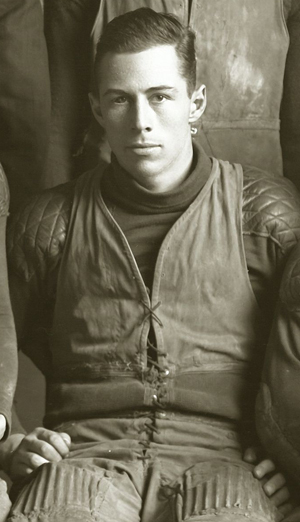
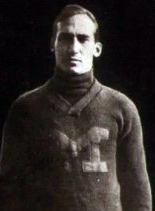
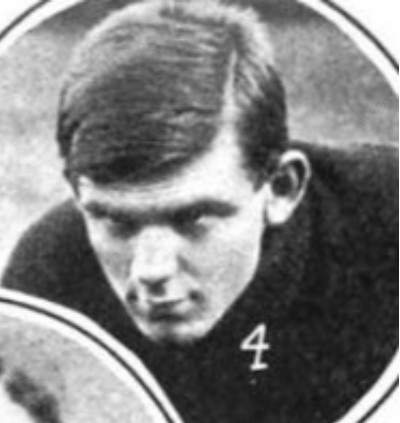
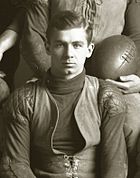
L-R: Harry Hammond, Mason Rumney, Bob Blake, William Wasmund
Visitors Capitalize on Fumble
Finally, the Wolverines got a break that led to their second field goal. Costen, who would muff six punts during the game, fumbled, and HB Prentiss Douglas recovered on the five. Two runs and an incomplete pass gained nothing. So Graham kicked another field goal to double Michigan's lead to 8-0.
If you didn't like punting, the second half was a colossal bore. The Michigan forward wall continued to bottle up the Vanderbilt offense. The Michigan Alumnus singled out C Adolph "Germany" Schulz as "far and away the star of the game. In his usual style, he was in every play, tackling runners for loss, falling on the ball in fumbles, and opening wide holes in the line for Michigan gains ... He showed conclusively that he has no equal in the keystone position."
The best chance for either team to score came late in the half when Michigan drove deep into Vanderbilt territory aided by a 25y punt return by QB William Wasmund and a 15y holding penalty on the Commodores. The Wolverines reached the 15 before turning the ball over on downs.
When Vanderbilt punted back, Graham tried a field goal that failed.
FINAL SCORE: MICHIGAN 8 VANDERBILT 0
Vanderbilt won their last three games to finish the season 6-1-1. Michigan's perfect season was spoiled by Pennsylvania the next week, 6-0 in Ann Arbor. The six points were the only ones scored on the Wolverines in 1907.
References
Bury Me in an Old Press Box: Good Times and Life of a Sportswriter, Fred Russell (1957)
Vanderbilt Football: Tales of Commodore Gridiron History (Kindle), Bill Traughber (2011)
Stagg vs Yost: The Birth of Cutthroat Football, John Kryk (2015)
Bury Me in an Old Press Box: Good Times and Life of a Sportswriter, Fred Russell (1957)
Vanderbilt Football: Tales of Commodore Gridiron History (Kindle), Bill Traughber (2011)
Stagg vs Yost: The Birth of Cutthroat Football, John Kryk (2015)